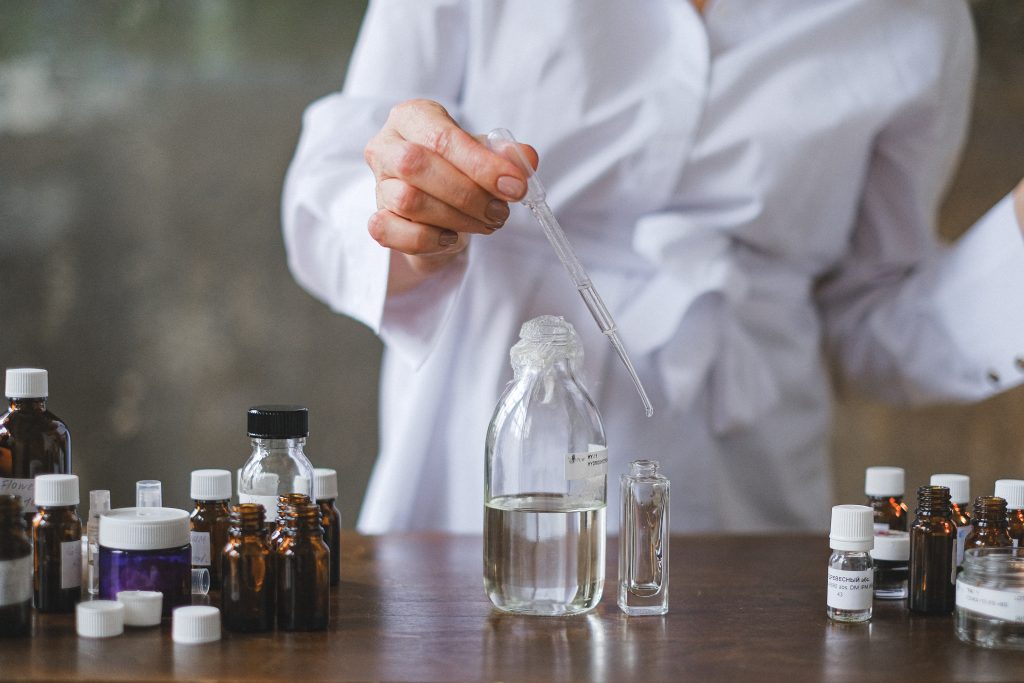IQ: I-question, L’ali's World, Neutraceuticals
Production technologies
Molecular Bioliquefaction® Technology
Molecular Bioliquefaction is a patented biotechnology developed by the “Toso Montanari” Department of Industrial Chemistry of the University of Bologna. This enzyme-based technology enables the recovery of 100% of the plant’s bioactive compounds in a fully bioavailable and active form as water-based liquid ingredients. Thousands of different and interesting target molecules are present in plants, and many of them cannot be extracted by a traditional solvent-based process, which is not effective on molecules covalently bound to the solid part of the plant. The technology was developed to overcome the limitations of traditional extraction technologies.
Enzymatic activation of vegetable oils
А biocatalytic process capable of breaking down triglycerides in oils to their constituent parts (fatty acids and glycerides), releasing all the energy embedded in the vegetable oil. In nature, oils are one of the most efficient forms of energy and carbon storage and the first cosmetic ingredient ever used. As with plant germination, human cells are unable to directly take up and metabolize triglycerides. When our cells have a specific metabolic need associated with triglycerides transported by plasma lipoproteins, these triglycerides must undergo an activation process catalyzed by specific enzymes. This process allows free fatty acids and glycerides to cross the cell membrane via active and passive transport mechanisms and be used in the various metabolic pathways.
Stem cell extraction
The use of plant stem cells to create new active ingredients has a number of advantages over the more commonly used methods of obtaining plant extracts – fresh material is constantly available, which no longer depends on the season or environmental conditions; easy standardization, since each batch of the product is of the same high quality and yield; the extracted compounds are safe and pure because the cells are grown under sterile and controlled conditions, thus there is no risk of pathogens or environmental contamination; no agricultural land is exploited, less water consumption and less waste. Another advantage is flexibility: cells can be induced to produce a higher level of specific compounds of interest. Finally, in most cases the extraction process is easier and does not take much time.
Liposomes
An efficient and completely natural system for delivering ingredients to the inner layers of the skin, which can be used to protect and enhance the effectiveness of active molecules. Natural liposomes are spherical vesicles consisting of phospholipid bilayers. The chemical structure of phospholipids in an aqueous environment forces these molecules to rearrange, creating a bilayer with hydrophilic properties on both the inner and outer surfaces. These liposomes can therefore be used to facilitate the penetration into the cell of water-soluble active substances contained in the liposomes, but also of oil-soluble active substances that can be incorporated into the bilayer structure.
Aqueous microdispersion
Most widely used active ingredients are water-soluble and easily incorporated into cosmetic products. But some specific ingredients, such as lycopene for example, are fat-soluble and this suggests a new type of technology – microdispersion. It represents the uniform distribution in an aqueous environment of an insoluble component, thus it becomes easy to apply and is more easily absorbed by the skin
Hyperfermentation
For thousands of years, fermentation has provided many cultures with the means to transform food, increasing its nutritional value and making it easier to digest. This millennial know-how, typical of the Mediterranean area, combined with the latest biotechnologies, and in particular the Bioliquefaction process, has led to the development of a new production process in which the phytocomplex naturally contained in the plant is enhanced thanks to fermentation, transforming the inert mass into even more active ingredients.
Distillation
An ancient method of extracting active ingredients from plants, and today – highly refined. Most essential oils are obtained by steam distillation, but a number of variations of the process can be used to obtain other moleciles. It preserves the characteristics of the extracted substance, so that its biological functions can be transmitted to the cosmetic product in which it is inserted.
Extraction
Plant extracts are liquid preparations obtained from fresh or dried medicinal plants by appropriate physical extraction processes. These include the use of suitable solvents and the use of maceration or percolation or other suitable procedures. To ensure the proper extraction of the substances, the plants must be ground to an appropriate degree of fragmentation, while the choice of solvent depends on the type of active ingredients to be extracted.
Hydrolysis
Plants contain a number of biologically active compounds with therapeutic potential. These compounds are either embedded in the cell wall matrix or bound to polymers in the cell cytoplasm, making it difficult to release bioactive compounds during extraction. Hydrolysis of cell wall and cytoplasmic polymers enhances the release of biocompounds while preserving their biological capabilities.
Photo: Anna Shvets


